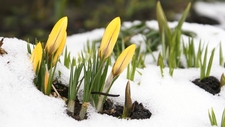Seasons

TEKS Objective
The student is expected to identify factors in the environment, including temperature and precipitation that affect growth and behavior such as migration, hibernation, and dormancy of living things.
Essential Understanding
The student knows that living organisms have basic needs that must be met for them to survive within their environment.
Science Background
What Causes the Seasons? Windows to The Universe (website) - Learn about common misconceptions regarding Earth’s seasons and discover the real reason for Earth’s seasonal shifts.
What Causes the Seasons?
Windows to The Universe, www.windows2universe.org
Reasons for Seasons: Journey North (website) - All seasonal changes—temperature, plant growth and life cycles, animal migrations, etc.—are driven by changes in the amount and intensity of available sunlight. This website provides helpful background information about seasons on Earth.
Reasons for Seasons
Journey North, The Annenberg Foundation, www.learner.org
Winter Adaptations of Animals: Michigan Forests Forever (website) - In northern climates, winter is the most stressful season for most forms of life. Read about different ways that animals cope and survive during this time of year.
Winter Adaptations of Animals
Michigan Forests Forever, mff.dsisd.net
Signature Lesson
How Do Seasons Affect Animal Adaptations? Teacher Vision (PDF) - Animals have different ways of adapting to seasonal change. In this lesson, students identify environmental and climatological factors that influence animals’ seasonal habits, and classify animals as adapters, hibernators, or migratory.
How Do Seasons Affect Animal Adaptations?
Teacher Vision, www.teachervision.fen.com
- Supporting Lessons
- Extensions
- Assessment Ideas
- Literature Connections
- Related
TEKS - Additional Resources
Supporting Lessons
Signs of the Seasons: Journey North (website) - Use an online slide show to explore seasonal changes and make a Seasons Showcase in your classroom.
Signs of the Seasons
Journey North, The Annenberg Foundation, www.learner.org
Nature Kids, Winter Bird Feeders: Nature Discovery Center (PDF) - Make a variety of different bird feeders to help the local bird population survive through the winter. Includes tips for setting up the bird feeders and background information about winter birds.
Nature Kids, Winter Bird Feeders
Nature Discovery Center, www.naturediscoverycenter.org
Nature Kids, Fall Flower Search: Nature Discovery Center (PDF) - We often think of spring or summer as the time for flowers, but there are many fall flowers, too. In this activity, students investigate the fall flowers in your area and chart how many insects or other animals they find visiting these flowers.
Nature Kids, Fall Flower Search
Nature Discovery Center, www.naturediscoverycenter.org
Elaboration Lessons and Extensions
Bird Biology, Building a Bird Feeder: SeaWorld/Busch Gardens (PDF) - For most animals, food becomes scarcer during winter. Use this activity to help your students build a feeder for the birds in your area and to recognize at least two different species of birds that come to feed.
Bird Biology, Building a Bird Feeder
SeaWorld/Busch Gardens, www.swbg-animals.org
Polar Bears Versus Penguins, Pole to Pole Learning Resource Guide: BBC/Discovery Channel/NHK (PDF) - Activities on page 8 and 9 demonstrate how polar bears and penguins adapt to the harsh environmental conditions of their Arctic and Antarctic homes.
Assessment Ideas
Assessment Strategies and Tools, Habitat and the Seasons: Journey North (website) - Several suggested activities to assess student understanding via words or drawings.
Literature Connections
Wake Me in Spring. Preller, James (ISBN-13: 978-0590475006)
How and Why Animals Prepare for Winter. Pascoe, Elaine (ISBN-13: 978-1574716641)
Sleepy Bear. Dadcovich, Lydia (ISBN-13: 978-0140547856)
Look How It Changes! Young, June (ISBN-13: 978-0516281780)
Additional Resources
From the Birds: The Humane Society of the United States (PDF) - Many people put bird feeders in their yards during the winter to provide the food birds need to survive. Use this worksheet to thank a bird lover.
From the Birds
The Humane Society of the United States, www.humanesociety.org
Pole to Pole Learning Resource Guide: BBC/Discovery Channel/NHK (PDF) - This guide provides teacher background information and student activities that teach about the water cycle, the role of the sun in driving Earth’s climate, and how animals in different parts of the world have adapted to the seasonal changes in temperature and light.
Pole to Pole Learning Resource Guide
BBC/Discovery Channel/NHK, dsc.discovery.com
TEKS Navigation
Grade 2
Need Assistance?
If you need help or have a question please use the links below to help resolve your problem.

Comments